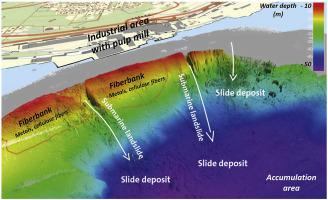Environmental Pollution ( IF 8.9 ) Pub Date : 2020-07-07 , DOI: 10.1016/j.envpol.2020.115182 Anna Apler 1 , Ian Snowball 2 , Sarah Josefsson 3

|
The boreal forest’s pulp and paper industry plays a major role in economic prosperity but, historically, caused an environmental burden. Remnants of discharges of contaminated suspended solids (fiberbanks) are continuously being discovered on the beds of shallow seas, rivers and lakes in the northern hemisphere. We investigated the dispersion of Cd, Cr, Cu, Hg, Ni, Pb and Zn from deeper to surficial layers in fiberbanks in a Swedish estuary and the larger-scale transport of the same metals to distal areas of sediment accumulation. We also tested the C:N ratio as a common denominator for these anthropogenic, cellulose-rich deposits. Sampling and analyses of three fiberbanks located in the inner part of the estuary and from sediment accumulation sites outside and along the estuary reveals that metal concentrations are regressing to background levels towards the surface at the accumulation sites. The fiberbanks show a higher degree of contamination and C:N ratios demonstrate inclusion of cellulose fibers. C:N ratios also indicate that there is currently no significant transport of fiberbank material into the distal areas. A ∼10 cm natural cap of recently settled fine-grained sediment covering one of the fiberbanks seems to prevent metals dispersing into overlying water whereas the other two fiberbanks show signs of metal enrichment and potential mercury methylation in surficial layers. Although the estuarine system seems to recover from the impact of industrial waste, there is no evidence that the fiberbanks will be remediated naturally but instead will continue to threaten the aquatic environment.
中文翻译:

从河口工业污染的沉积物中分散纤维素纤维和金属。
北方森林的纸浆和造纸业在经济繁荣中起着重要作用,但历史上却给环境造成了负担。在北半球浅海,河流和湖泊的河床上不断发现被污染的悬浮固体(纤维堆)的残留物。我们研究了瑞典河口的纤维库中Cd,Cr,Cu,Hg,Ni,Pb和Zn从深层到表层的弥散,以及将相同金属更大规模地输送到沉积物堆积的远端区域。我们还测试了C:N比作为这些人为的,富含纤维素的沉积物的共同点。对位于河口内部且来自河口外部和沿河口沉积物堆积点的三个纤维库的采样和分析表明,金属浓度正朝着堆积点处的表面回归到本底水平。纤维库显示出较高的污染程度,C:N比表明包含纤维素纤维。C:N比值还表明,目前没有大量的纤维库材料进入远端区域。用一个约10厘米的自然沉降的最近沉降的细颗粒沉积物覆盖纤维库之一,似乎可以防止金属扩散到上层水中,而另两个纤维库则在表层显示出金属富集和潜在的甲基化甲基的迹象。尽管河口系统似乎已从工业垃圾的影响中恢复过来,



























 京公网安备 11010802027423号
京公网安备 11010802027423号